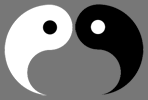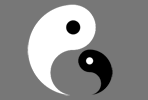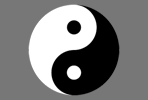
Zoroastrianism

Gnosticism

Taoism
Gnostic Taoism
While reading and pondering contemporary debates about “philosophical” vs. “religious” taoism, I cannot help but compare the distinction to that between “mystical” vs. “orthodox” strains of western religion. Some peple thrive on structure and ritual, but others would rather do without ecclesiastical trappings and go straight to the source, seeking experiential knowledge (gnosis) and living personal insight.
For going on two millenia, a certain type of belief and practice has existed on the fringe of orthodox western religion, working its way in at times to varying degrees, and usually becoming the target of vigorous, sometimes shockingly violent opposition and suppression. A moden umbrella term for this type of belief is gnosticism. The core concept is a search for experiential knowledge, the knowledge that goes beyond “I know who Mary is” to “I know Mary.” The kind of knowledge that inspired Carl Jung to say, “I don't need to believe, I know.”
 Zoroastrianism |
 Gnosticism |
 Taoism |
A common feature of western gnostic traditions is dualism of some sort. Absolute dualists like Zoroastrians and Manichaeans believe that opposing forces of good and evil have both existed from eternity, and that the battle between them is real. Mitigated dualists see one of the forces, usually evil, as inferior to the other. The material world is typically believed to be the creation of a flawed creator, a place of suffering from which the spark of the divine inside our dying bodies seeks to escape through gnosis.
I believe that gnosticism is able to inform taoism, by validating the mystic’s search for experiential knowledge and living, here-and-now insight. This search will go on no matter what form “religious” taoism takes across time and cultures. And taoism offers to gnosticism what I believe is a more accurate form of dualism, the complementary dualism (perhaps better described as a dialectical monism) of yin and yang. They are the ultimate syzygy; there is no light without darkness, no good without evil. This is true of all creation, in whole and in all of its parts. The goal of gnosis is to experience the wholeness of one’s being as a manifestation of the original One, the Tao.
The First Sermon to the Dead
Carl Jung’s Seven Sermons to the Dead, written early in his career, are an expression of what may be called gnostic depth psychology. The first sermon is a very eloquent expression of how the One becomes the many by its differentiation into complementary and inseparable qualities. Dr. Jung uses the word pleroma (fullness) to refer to what I believe is more properly called the One, the ultimate source of all. (In classical gnosticism, the pleroma is the fullness of all the emanations from the One, the Aeons, which make up the spiritual world.)
I have taken the liberty of reproducing the first sermon below, with the word pleroma replaced by the word Tao.
VII Sermones ad Mortuos
(Seven Sermons to the Dead)
C. G. Jung, 1916
(Translation by Stephan A. Hoeller, © 1982,
with the word pleroma replaced by the word Tao)
Seven exhortations to the dead, written by Basilides in Alexandria, the city where East and West meet.
The First Sermon
The dead came back from Jerusalem, where they did not find what they were seeking. They asked admittance to me and demanded to be taught by me, and thus I taught them:
Hear Ye: I begin with nothing. Nothing is the same as fullness. In the endless state fullness is the same as emptiness. The Nothing is both empty and full. One may just as well state some other thing about the Nothing, namely that it is white or that it is black or that it exists or that it exists not. That which is endless and eternal has no qualities, because it has all qualities.
The Nothing, or fullness, is called by us the TAO. In it thinking and being cease, because the eternal is without qualities. In it there is no one, for if anyone were, he would be differentiated from the Tao and would possess qualities which would distinguish him from the Tao.
In the Tao there is nothing and everything: it is not profitable to think about the Tao, for to do that would mean one’s dissolution.
The CREATED WORLD is not in the Tao, but in itself. The Tao is the beginning and end of the created world. The Tao penetrates the created world as the sunlight penetrates the air everywhere. Although the Tao penetrates it completely, the created world has no part of it, just as an utterly transparent body does not become either dark or light in color as the result of the passage of light through it. We ourselves, however, are the Tao, so it is that the Tao is present within us. Even in the smallest point the Tao is present without any bounds, eternally and completely, for small and great are the qualities which are alien to the Tao. The Tao is the nothingness which is everywhere complete and without end. It is because of this that I speak of the created world as a portion of the Tao, but only in an allegorical sense; for the Tao is not divided into portions, for it is nothingness. We, also, are the total Tao; for figuratively the Tao is an exceedingly small, hypothetical, even non-existent point within us, and also it is the limitless firmament of the cosmos about us. Why, however, do we discourse about the Tao, if it is the all, and also nothing?
I speak of it, in order to begin somewhere, and also to remove from you the delusion that somewhere within or without there is something absolutely firm and definite. All things which are called definite and solid are but relative, for only that which is subject to change appears definite and solid.
The created world is subject to change. It is the only thing that is solid and definite, since it has qualities. In fact, the created world is itself but a quality.
We ask the question: how did creation originate? Creatures indeed originated but not the created world itself, for the created world is a quality of the Tao, in the same way as the uncreated; eternal death is also a quality of the Tao. Creation is always and everywhere, and death is always and everywhere. The Tao possesses all: differentiation and non-differentiation.
Differentiation is creation. The created world is indeed differentiated. Differentiation is the essence of the created world and for this reason the created also causes further differentiation. That is why man himself is a divider, inasmuch as his essence is also differentiation. That is why he distinguishes the qualities of the Tao, yea, those qualities which do not exist. These divisions man draws from his own being. This then, is the reason for man discoursing about the qualities of the Tao, which do not exist.
You say to me: What good is it then to talk about this, since it has been said that it is useless to think about the Tao?
I say these things to you in order to free you from the illusion that it is possible to think about the Tao. When you speak about the divisions of the Tao, we are speaking from the position of our own divisions, and we speak about our own differentiated state; but while we do this, we have in reality said nothing about the Tao. However, it is necessary to talk about our own differentiation, for this enables us to discriminate sufficiently. Our essence is differentiation. For this reason we must distinguish individual qualities.
You say: What harm does it not do to discriminate, for then we reach beyond the limits of our own being; we extend ourselves beyond the created world, and we fall into the undifferentiated state which is another quality of the Tao. We submerge into the Tao itself, and we cease to be created beings. This we become subject to dissolution and nothingness.
Such is the very death of the created being. We die to the extent that we fail to discriminate. For this reason the natural impulse of the created being is directed toward differentiation and toward the struggle against the ancient, pernicious state of sameness. The natural tendency is called Principium Individuationis (Principle of Individuation). This principle is indeed the essence of every created being. From these things you may readily recognize why the undifferentiated principle and lack of discrimination are all a great danger to created beings. For this reason we must be able to distinguish the qualities of the Tao. Its qualities are the PAIRS OF OPPOSITES, such as
The pairs of opposites are the qualities of the Tao: they are also in reality non-existent because they cancel each other out.
Since we ourselves are the Tao, we also have these qualities present within us; inasmuch as the foundation of our being is differentiation, we possess these qualities in the name and under the sign of differentiation, which means:
First—that the qualities are in us differentiated from each other, and they are separated from each other, and thus they do not cancel each other out, rather they are in action. It is thus that we are the victims of the pairs of opposites. For in us the Tao is rent in two.
Second—the qualities belong to the Tao, and we can and should partake of them only in the name and under the sign of differentiation. We must separate ourselves from these qualities. In the Tao they cancel each other out; in us they do not. But if we know how to know ourselves as being apart from the pairs of opposites, then we have attained to salvation.
When we strive for the good and the beautiful, we thereby forget about our essential being, which is differentiation, and we are victimized by the qualities of the Tao which are the pairs of opposites. We strive to attain to the good and beautiful, but at the same time we also attain to the evil and the ugly, because in the Tao these are identical with the good and the beautiful. However, if we remain faithful to our nature, which is differentiation, we then differentiate ourselves from the good and the beautiful, and thus we have immediately also differentiated ourselves from the evil and the ugly. It is only thus that we do not merge into the Tao, that is, into nothingness and dissolution.
You will object and say to me: Thou hast said that differentiation and sameness are also qualities of the Tao. How is it then that we strive for differentiation? Are we not then true to our natures and must we then also eventually be in the state of sameness, while we strive for differentiation?
What you should never forget is that the Tao has no qualities. We are the ones who create these qualities through our thinking. When you strive after differentiation or sameness or after other qualities, you strive after thoughts which flow to you from the Tao, namely thoughts about the non-existent qualities of the Tao. While you run after these thoughts, you fall again into the Tao and arrive at differentiation and sameness at the same time. Not your thinking but your being is differentiation. That is why you should not strive after differentiation and discrimination as you know these, but strive after your true nature. If you would thus truly strive, you would not need to know anything about the Tao and its qualities, and still you would arrive at the true goal because of your nature. However, because thinking alienates us from our true nature, therefore I must teach knowledge to you, with which you can keep your thinking under control.
Acknowledgements:
The Seven Sermons to the Dead at the Gnostic Society Library (unfortunately with several typos and omissions)
|
by Stephan A. Hoeller
|
Gnostic Writings
Light and darkness, life and death, the right and the left are each other’s brothers. They cannot separate from one another. Therefore, the good are not good nor are the evil evil, nor is life life, nor death death. On account of this, each one will dissolve into its beginning origin. But those who are exalted above the world cannot dissolve; they are eternal.
—The Gospel of Phillip
He is the invisible Spirit of whom it is not right to think of him as a god, or something similar. For he is more than a god, since there is nothing above him, for no one lords it over him. For he does not exist in something inferior to him, since everything exists in him. For it is he who establishes himself. He is eternal since he does not need anything. For he is total perfection. He did not lack anything that he might be completed by it; rather he is always completely perfect in light. He is illimitable since there is no one prior to him to set limits to him. He is unsearchable since there exists no one prior to him to examine him. He is immeasurable since there was no one prior to him to measure him. He is invisible since no one saw him. He is eternal since he exists eternally. He is ineffable since no one was able to comprehend him to speak about him. He is unnameable since there is no one prior to him to give him a name.
He is immeasurable light which is pure, holy, and immaculate. He is ineffable being perfect in incorruptibility. He is not in perfection, nor in blessedness, nor in divinity, but he is far superior. He is not corporeal nor is he incorporeal. He is neither large nor is he small. There is no way to say, ‘What is his quantity?’ or, ‘What is his quality?’, for no one can know him. He is not someone among other beings, rather he is far superior. Not that he is simply superior, but his essence does not partake in the aeons nor in time.
—The Secret Book of John (The Apocryphon of John)
When you make the two one, and when you make the inside like the outside and the outside like the inside, and the above like the below, and when you make the male and the female one and the same, so that the male not be male nor the female female . . . then will you enter the kingdom.
—The Gospel of Thomas
|
by Bart D. Ehrman
|
|
by Marvin W. Meyer (Editor)
|